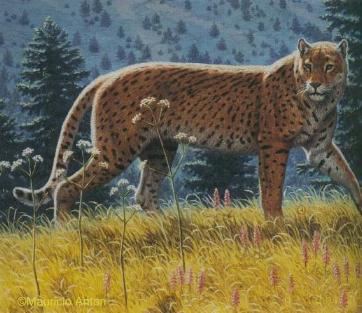Kingdom Animalia Subfamily Felinae Phylum Chordata Higher classification Felinae | Family Felidae Scientific name Miracinonyx Order Carnivores Rank Genus | |
 | ||
Similar Mammal, Felidae, Giant cheetah, American lion, Homotherium | ||
Did the american cheetah make the pronghorn fast
The American cheetah (Miracinonyx) is an extinct genus of at least two feline species, which were endemic to North America during the Pleistocene epoch (2.6 Ma – 12,000 years ago) and morphologically similar to the modern cheetah (Acinonyx jubatus). These cats are only known from fragments of skeletons.
Contents
- Did the american cheetah make the pronghorn fast
- The north american cheetah
- Taxonomy and evolution
- Miracinonyx trumani
- Miracinonyx inexpectatus
- References

The two species commonly identified are Miracinonyx inexpectatus and M. trumani. Sometimes a third species, M. studeri, is added to the list, but it is more often listed as a junior synonym of M. trumani. Both species are similar to the modern cheetah, with faces shortened and nasal cavities expanded for increased oxygen capacity, and legs proportioned for swift running. However, these similarities may not be inherited from a common ancestor, but may instead result from either parallel or convergent evolution. These were larger than a modern cheetah and similar in size to a modern northern cougar. Body mass was typically around 70 kg (150 lb), with a head-and-body length of 170 cm (67 in), tail length of around 92 cm (36 in) and a shoulder height of 85 cm (33 in). Large specimens could have weighed more than 95 kg (209 lb).

The north american cheetah
Taxonomy and evolution

Research into the American cheetah has been contradictory. It was originally believed to be an early cougar representative, before being reclassified in the 1970s as a close relative of the cheetah. This suggested that the ancestors of the cheetah diverged from the Puma lineage in the Americas and migrated back to the Old World, a claim repeated as recently as 2006 by Johnson et al. Other research by Barnett, however, examining mitochondrial DNA and re-analyzing morphology, has suggested reversing the reclassification: the American cheetah developed cheetah-like characteristics through parallel evolution, but it is most closely related to Puma and not to the modern cheetah of Africa and Asia. The supposed American origin of the modern cheetah is thus equivocal; however, it is believed to have evolved from cougar-like ancestors, whether in the Old World or the New World.
The cougar and M. trumani are believed to have split from a cougar-like ancestor around three million years ago; where M. inexpectatus fits in is unclear, although it is probably a more primitive version of M. trumani.
Miracinonyx trumani
M. trumani was the animal morphologically most similar to true cheetahs. Living on the prairies and plains of western America, it was probably a predator of hoofed plains animals, such as the pronghorn. In fact, predation by Miracinonyx is thought to be the reason why pronghorns evolved to run so swiftly, their 60-mph top speed being much more than was needed to outrun extant American predators, such as cougars and gray wolves.
Miracinonyx inexpectatus
M. inexpectatus was more similar to the cougar than was M. trumani, its proportions being between that of the cougar and M. trumani. It had fully retractable claws and, with its lighter build, M. inexpectatus was probably faster than the cougar. Thanks to its retractable claws, it is also possible that it was more adept at climbing than M. trumani.
